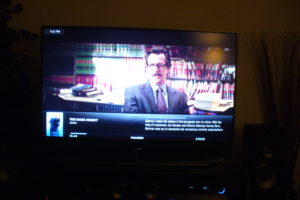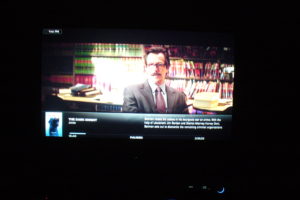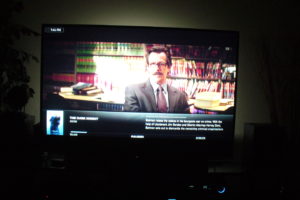My Impression of Bias Lighting
Several years ago I was shopping around for a new HDTV to splurge on. I spent months pouring over reviews on CNET, reading threads on AVS Forum, and walking around Best Buy to find the perfect HDTV. I found AVS Forum to be the best resource of good information because you could ask specific questions, and there was most likely someone on the forum who could answer it based on personal experience (and who knew what the heck they were talking about unlike most retail employees).
During that search, I came across the concept of bias lighting. This is not the colored ambient lighting crap that some TVs use as a marketing gimmick—colored back-lighting actually screws up your perception of contrast, color tone, etc. This is the lighting that professionals use with a professionally-calibrated monitor so they can edit video. I could go off on a tangent about why I prefer to see movies the way the director and editor intended, but I’ll save that for another post…
The basic idea with bias lighting is that you reduce eyestrain and perceive contrast better if there is a small amount of light behind the TV or monitor that you are watching. I won’t get into the specifics, but suffice to say that you shouldn’t throw any old lamp or cold cathode behind your TV. If you want to read more about the concept, here are a few links to get you started:
- The Importance of Bias Lighting When Viewing in a Reference Environment
- About the “Ideal Viewing Environment”
- Video Bias Lighting (SMPTE Recommended Practice- CIE D65/6500K White Light Only)
I always wanted to get a bias light for my TV, even though I never had it professionally calibrated, because I always liked the idea of having a little bit of light in the room at night rather than burning my retinas with a bright image in a totally dark room, and most lights cast reflections on the TV screen that are very distracting during darker scenes. As fortune would have it, I moved into a new apartment recently and it has no built-in lighting in the living room, but it does have a switched outlet right next to my TV. This was the last bit of motivation for me to finally get a bias light. The thought of adding a little light to the room while improving the TV viewing experience at the flick of a switch is very appealing, don’t you think?
After some forum lurking, I decided to go with the Ideal-Lume standard from CinemaQuest, Inc. I ordered it directly from the CinemaQuestInc.com website. It was shipped via UPS and arrived in a box packed with foam and bubble-wrap. Inside the box was another box. Inside this box was the Ideal-Lume standard and a spare bulb, each packed in more bubble-wrap. They also helpfully included adhesive velcro strips, two sizes of zip-ties, and drywall anchors and screws. They even included an alcohol cleaning pad to prep the mounting surface for the adhesive velcro strips.
The documentation in the package provided several suggestions for mounting the light. I chose to use the velcro strips (there are 3 pairs) and stick it to the back of my TV. After a quick dusting and swabbing, I mounted the light and turned it on.
The light is a very pure white; it reminds me of the “daylight” bulbs you can buy nowadays. I adjusted the built-in light shade so it didn’t shine too much light above the TV. After a couple of tries I managed to get a nice, even dispersal across the wall behind the TV to provide a soft and subtle effect. Fortunately my walls are cream (nearly white), which is recommended for the best viewing experience.
So, the big question is, did I notice a difference in picture quality or a reduction in eyestrain? The answer is “probably.” I want to say yes, but part of me thinks that it might just be a subconscious perception of improvement because I believe that it will work. I can definitely say that I haven’t encountered any eyestrain since installing it, but I can’t say with certainty that it’s because of the light and only the light. Regardless, I’m very happy to have a subtle light source that I can turn on conveniently with a light switch as I walk into the living room. I attached a few photos so you can get an idea of how it looks. These were snapped very quickly with my point-and-shoot camera, so don’t use them as a true reference for how well bias lighting works.



Has anyone else tried bias lighting? Does it improve your viewing experience?